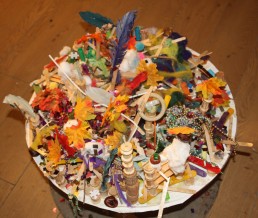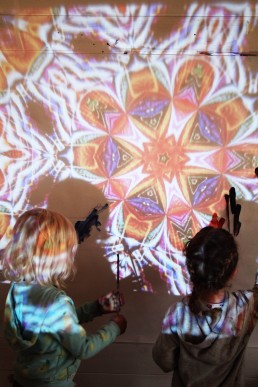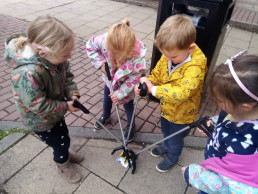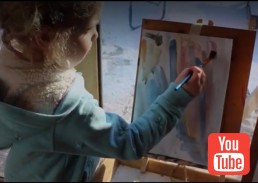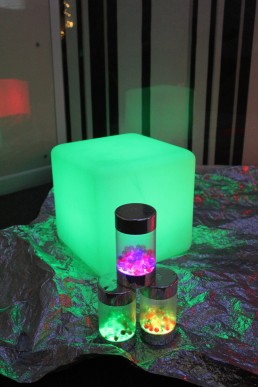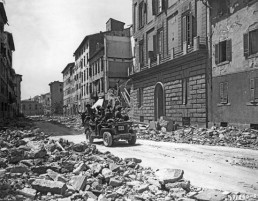The Sticking Table
Much more than just loose parts and glue
 Back in June, shape and structure created from loose parts became a shared interest, the children would make 2D shapes and arrangements with lolly pop sticks. Naturally this progressed into 3D shapes as the children explored the idea of building upwards with bobbins and corks added in.
Back in June, shape and structure created from loose parts became a shared interest, the children would make 2D shapes and arrangements with lolly pop sticks. Naturally this progressed into 3D shapes as the children explored the idea of building upwards with bobbins and corks added in.
We wanted to find a way of making these structures more permanent, a way of their models being able to interact with each other instead of standing alone on a shelf. From here the Sticking table was created!
An old repurposed cable reel became a platform for these structures and ideas to play out, and old objects took on new roles with the help of some glue, a lot of glue in fact.
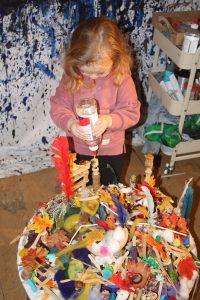

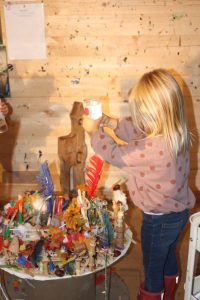
‘Sticky sticky glue’
The glue is poured from squirty bottles from heights, or from close distance, the children watch it pour and dribble. They watch how it builds up and falls off certain surfaces onto a surface below. They practice their aiming skills and try again when the glue doesn’t land where they had in mind. Children love being able to access resources them selves, the joy and independence they get from unravelling tape and pouring glue can’t always be fulfilled at home due to mess and waste, so this was the perfect place for them to pour glue to their hearts content. We used PVA, clear glue, old pen lids destined for the bin, feathers, wool, bobbins and sticks and each week the sticking table carried through with a new story.
The sticking table has been a house, a nest, a city, and a dragon house. For now the sticking table is going though a seasonal autumnal phase as conkers and leaves are added to the mix.
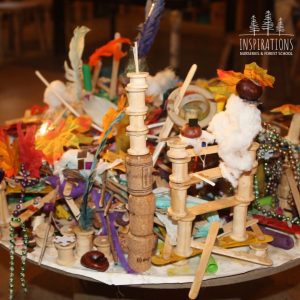
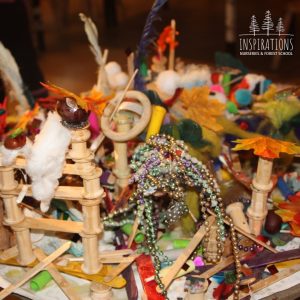
Having a long term project along side other activities can be a great way to allow children to practice and repeat skills, by revisiting ideas from weeks before they are able reflect on their ideas and build confidence. Schemas are a repeated pattern of behaviour that a child will go through whilst discovering how the world works. It is through this urge of repetition our children are given the time and opportunity to extend on their thinking and learning.
It can be hard as educators to have the chance to leave a project out, tidy up time is a necessity particularly in spaces where meal times take place. So the sticking table is the perfect place for them to come back to a scene that has not been tidied away from the last time they were in the Art Studio. The perfect opportunity for them to deepen their cognitive development. Because how else can our children reflect on their work and ideas when they return to a project that has been tidied away.
Only the children can predict where the sticking table will go next, but as each new group of creative minds come together to take ownership of it, it will, no doubt, take on a brand new adventure and identity over the coming weeks and months.
-Nathalie
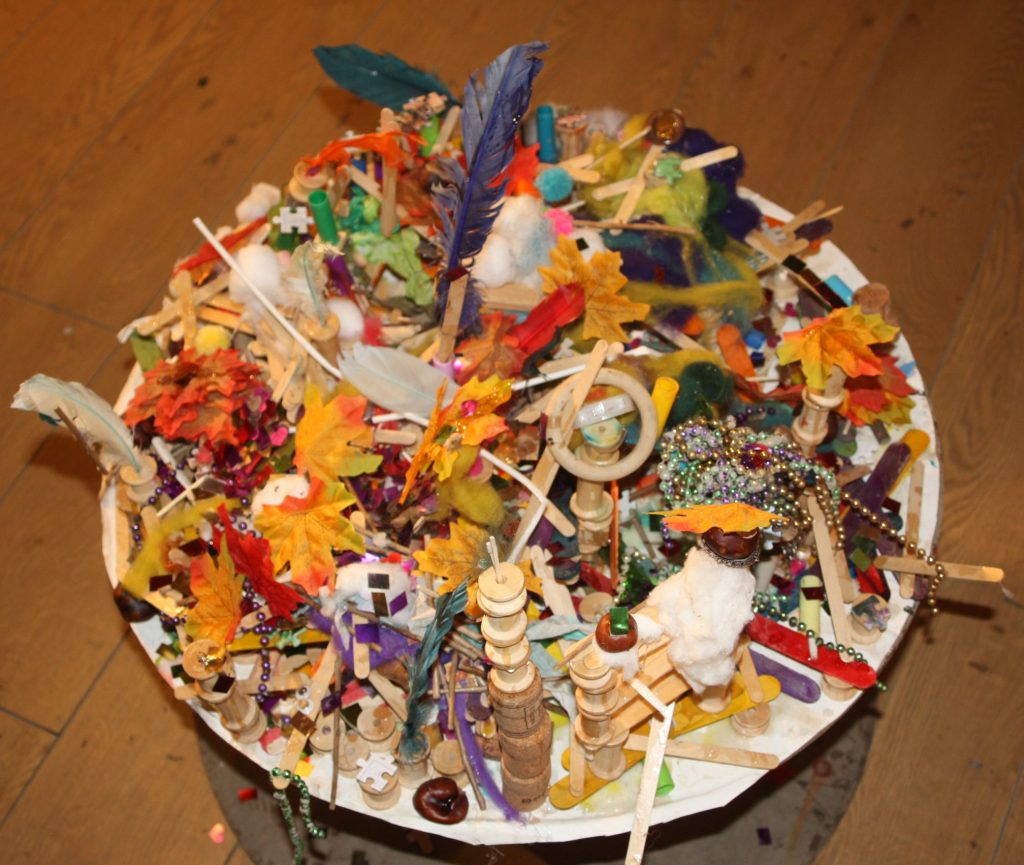
Exploring Pattern in the Art Studio
This week in the Art Studio has had a child led focus on pattern, but how did we get there? Last month we found a butterfly on the decking that was no longer alive. The children shared ideas on what might have 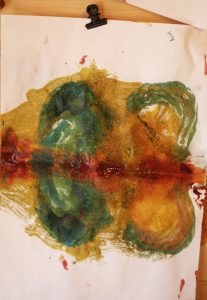 happened? 'It got stung by a wasp!' 'It was eaten by a fox!'
happened? 'It got stung by a wasp!' 'It was eaten by a fox!'
Whilst they came to their own conclusions we brought the butterfly into the Art Studio for a close examination. Out came all the research books as we identified it as a 'Speckled Wood'. The butterfly inspired some drawings, which lead onto paintings with particular focus on the wing patterns and colours.
This naturally lead onto art work and printing techniques by folding the paper to make prints of butterfly wings as we learnt a new word 'Symmetrical'. Their symmetrical patterns progressed and this interest strayed away from the butterfly and lead onto pattern within art using various techniques.
This week we took our pattern painting onto a large scale with the added media of light and shadow as a kaleidoscope was projected onto the wall. We also used clay to create pattern by imprinting beads and various other loose parts.
The Art Studio as well as being a Reggio Inspired place to explore project based learning is also a space for our children to explore new surroundings and new friendships in smaller groups. For some it is their space to build with the magnets, notice new books, experiment with different art materials and explore shadows on the projector. It is a space that can be quiet, a space that can be loud, where we play instruments and sing with the ukulele, and a space with provocations, a space that is rearranged whenever new interests emerge. With between 6 and 8 children in each session it can be the perfect opportunity to hear the children's voices which guides our planning.
Here's some of this weeks photos from the Art Studio.
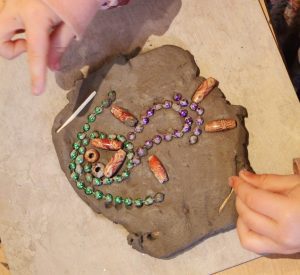

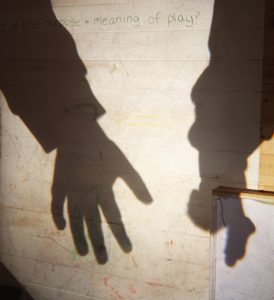
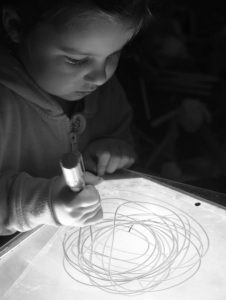
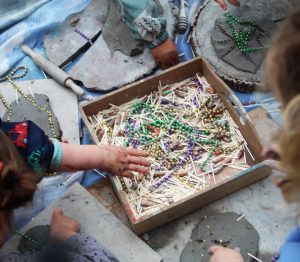
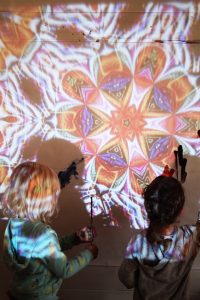

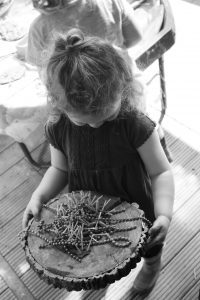
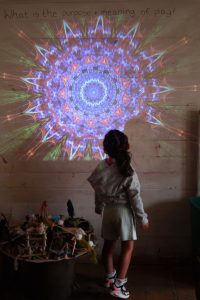
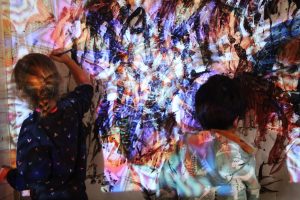
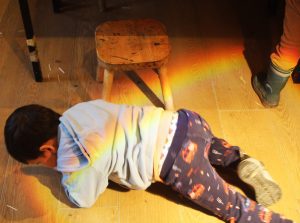
Little Litter Pickers
It was during one of our daily Forest School trips that one of our Pre-School children expressed disappointment at finding litter on the ground. We decided to order some litter pickers and set out on an adventure to clean up Horsforth.

At least once a week now a small group set off around Horsforth with Litter Pickers and a bag, collecting every item of trash they see along the way. So far we have met some wonderful people who stop and thank the children. It's a wonderful way of getting exercise, meeting our locals and helping our community.
Watch the video here-
https://www.youtube.com/watch?v=5N-yULXVwjk
We're proud of our children for noticing the world around them and caring about the place they live. Would you like to help make Horsforth a cleaner place? Check out the Horsforth Litter Pickers group on facebook.
Seekers of Meaning
New Video
Over the last few weeks I have been filming the children as they explore the Art Studio. To read more about our Art studio you can go back to last weeks blog.
The children's current shared interest is construction and building houses from clay, bricks, sticks and blocks. Some of that is captured in our brand new video that you can watch here-
https://www.yout ube.com/watch?v=4-59qb9GgdQ
ube.com/watch?v=4-59qb9GgdQ
Pre-School at Adel
Are you longing to peer into the future, catch a glimpse of normality resuming once again? I think we can agree this is going on longer than we initially imagined, but here we are. We are still in this together, and we hope during these times of increased social distancing you can still maintain social connections online, just like those in this news story that brought a smile to our faces. https://www.bbc.co.uk/news/av/uk-55732174
So we start this blog by asking, how are you, and what are you grateful for? We are grateful to have our Inspirations Nurseries families that continue to bring a sense of community.
Last week our blog focused on our Horsforth Pre-School, so this week we hand over to Deborah our manager at Adel to talk about our other Inspirations Nursery only 10 minutes away.
Welcome to Adel
At Adel we take children from the age of three, to starting school. Like Horsforth, we follow the Reggio Emilia Approach, which comprises of loose parts, mirrors and reflection, natural resources and investigation of up-cycled and recycled trinkets and materials.



Our setting is within the grounds of Adel St John the Baptist Primary School which is surrounded by beautiful woods and trees. There’s a well-equipped natural garden with a climbing wall, workbench, piano, mud kitchen and bikes. We have the use of the super large playing field and the conservation area which we use twice weekly for Forest School.
Our planning involves the outdoors as much as indoors and the children can choose where they would like to play.
Inside we have a very spacious room with areas to promote learning wherever the children choose to be.
Set Out to Inspire
The aim of our pre-school environments is to inspire the children to want to explore and learn. We have a maths, literacy, construction, small world, home and creative area of which all have natural resources for the children to explore and a wide range of loose parts to promote maths, communication, imagination and problem solving.



After observing the children’s common interests, we plan as a team to add resources and challenges to the areas and talk to the children about what they know and what they want to know, and how they would like to learn.
The children’s key worker also plans for their key children’s individual interests to support and provide opportunities to progress in all areas of development. As we are a pre-school we encourage independence and all skills necessary for school readiness, such as being able to express their own needs, listen to others and stories, separate from their carer, independent self-care, and understanding of British Values which encourages respect for ourselves and others.
Phonic, Spanish and Creativity
We teach phonics which is differentiated to meet and challenge each child’s individual ability. At Adel we also introduce Spanish to the children; an introduction to languages through songs, games and activities promoting enthusiasm with learning languages later in school. We also have our own Atelierista who comes in 3 times a week to deepen creative projects in smaller groups.

Throughout both our Pre-School settings we support your children in becoming strong independent learners, enabling them to think critically and outside the box. Their use of imagination and their understanding of the world, alongside their ability to problem solve, will stand them out from the crowd and give them a head start in life.
If you love our nursery as much as we do, have any questions or are interested in joining us check out more on the website here-http://simonr30.sg-host.com/our-settings/adel/ or contact- deborah@inspirationsnurseries.co.uk
Learning through Light
The Reggio approach (as outlined in our previous blog) puts children at the centre of their own learning. The ethos is based around a hands on approach to learning, with art, materials, and loose parts used to create learning opportunities and encourage critical thinking; but one thing we haven't touched upon much is the use of light as a material.
If you explore our rooms at inspirations, or the photography on our Instagram and website you will see there are projectors, light boxes, and sensory dark dens throughout all of our spaces from the Baby Rooms up to Pre-School.

Why do we use light and shadow?
In the younger rooms the use of light cubes, fairy lights and projectors invite children to expand their natural curiosity and encourage babies to engage and remain focused for a longer period of time. As well as having a calming affect, this sensory experience also provides a different perspective, allowing the child to develop creative and critical thinking.

In the Toddler and Pre-School rooms we use over head projectors, torches and mirrors to allow the children to deepen their knowledge and understanding of light and space. Have you ever witnessed the first time a child acknowledged their own shadow?
Seeing their reaction just highlights the sense of magic and wonder that comes with light play. In the Reggio Approach we talk about natural objects a lot, and sun light alone is a completely free resource that should be utilised to support learning. Light and shadow can be a source of intrigue as children notice the way in which light changes the way things look. It gives the child the opportunity to witness the illumination of things around them, predict patterns, test their ideas and develop new concepts.
We set up a camera in our baby rooms to see how they interact with light, you can watch the video here-
At home why not set up an activity for your child based around lights, shadows or reflection using mirrors, we would love to be tagged in a photo of your activity on tapestry, Instagram or Facebook.
“light and certain light phenomena are central protagonists and highlight the extent to which expressiveness and beauty can accompany an understanding of scientific thinking.” - Vecci (Reggio Atelierista)



For more reading on this topic you can find 'Art and Creativity in Reggio Emilia: Exploring the Role and Potential of Ateliers in Early Childhood Education (Contesting Early Childhood)DF' on amazon.
- Nathalie (Atelierista)
The Reggio Emilia Approach
At Inspirations Nurseries and Forest School we follow the Reggio Approach to learning, but what's the back story, what are the circumstances that led to this approach being created?
Following the devastation of World War Two, Reggio Emilia and its neighbouring Italian cities were left war torn. The war left merely a foundation upon which to rebuild a town and a community from scratch, a place free from oppression, injustice and inequality. This brought together a community of people passionate to form a new educational system with the very little they had; with the aim of turning their future generations into capable, resourceful and resilient individuals.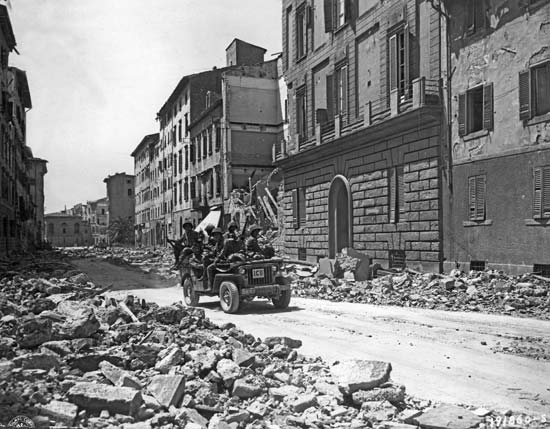
Local men and women of all ages came together to create a school for young children using materials from bombed out buildings. So from the very beginning these Reggio Emilia children were shown that something can be made from nothing, that creativity, perseverance and determination leads to opportunities and possibilities, and that anything can be made from the materials naturally surrounding us.
At inspirations we immerse ourselves and our children in this resourceful and passionate mind set, we too are a community that learn together, explore boundaries and strive to reach our full potential together.
http://simonr30.sg-host.com/news-and-blog/loose-parts/
As described in our previous blog, loose parts are a huge part of the Reggio Approach but there are many other aspect that guide our environment, planning and learning opportunities here at our Horsforth and Adel settings.


'The Real Thing'
Instead of plastic play food, cups and jugs in the mud kitchen and home corners we use real fruit and veg, real plates and utensils. There are so many more learning opportunities that come from using real up cycled natural resources, they can peel, cut, weigh and smell real fruit and vegetables, and real pot and pan will also teach the children the value of an object. They are more likely to handle real objects with care, value and precision than with a light plastic alternative.
The role of our educators is to listen to the children, to be present, challenge their ideas, and extend when learning opportunities arise. This brings us back to the importance of community within our setting, we as educators are here to be present with the children and to create learning opportunities in their environment for them to discover the answers them selves. When a child has the opportunity to discover the world independently, and learn answers through trial and error with the support of our educators and natural resources they grow up as capable, creative and resourceful humans, just like the inspiring people who came together to create the first Reggio Emilia Schools from the ground up.
‘We must credit the child with enormous potential and the children must feel that trust. The teacher must give up all his preconceived notions and accept the child and a co- constructor’ –Loris Malaguzzi

Our Horsforth Setting is located next to Hunger Hill Woods on West End Lane, to get in touch email kayleigh@inspirationsnurseries.co.uk
Our Adel Setting is located next to St John the Baptist Primary, to get in touch email deborah@inspirationsnurseries.co.uk
- Nathalie (Atelierista)
